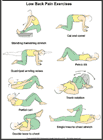Backache
What is a backache?
A backache is pain and stiffness in the back. The middle or lower back is the most common area to have pain. Backaches are more common during adolescence.
With a backache:
- The pain is worsened by bending.
- The muscles on either side of the spine are tender or in spasm.
What causes backaches?
Backaches are usually caused by straining some of the 200 muscles in the back that allow us to stand upright. Often the strain is caused by carrying something too heavy, lifting from an awkward position, or overexertion of back muscles (for example, from digging).
How long will it last?
The pain and discomfort are usually gone in 1 to 2 weeks. Recurrences are common.
How can I take care of my child?
- Pain-relief medicines
Give acetaminophen (Tylenol) or ibuprofen (Advil) 4 times a day. Continue this medicine until 24 hours have passed without any pain. This is the most important part of the therapy because back pain causes muscle spasm and these medicines can greatly reduce both the spasm and the pain.
- Local heat
A heating pad or hot water bottle applied to the most painful area for 20 minutes helps to relieve muscle spasm. Do this whenever the pain flares up.
- Sleeping position
The most comfortable sleeping position is usually on the side. The mattress should be firm or reinforced with a board.
- Activity
Have your child avoid lifting, jumping, horseback riding, motorcycle riding, and exercise until he is completely well. Complete bed rest is unnecessary.
How can backaches be prevented?
The only way to prevent future backaches is to keep the back muscles in excellent physical condition. This will require 5 minutes of back and abdominal exercises every day.
Helpful exercises are:
- Standing hamstring stretch: Place the heel of your
leg on a stool about 15 inches high. Keep your
knee straight. Lean forward, bending at the hips until
you feel a mild stretch in the back of your thigh. Make
sure you do not roll your shoulders and bend at the waist
when doing this or you will stretch your lower back
instead. Hold the stretch for 15 to 30 seconds. Repeat 3
times.
Repeat the same stretch on your other leg.
- Cat and camel: Get down on your hands and knees. Let your stomach sag, allowing your back to curve downward. Hold this position for 5 seconds. Then arch your back and hold for 5 seconds. Do 3 sets of 10.
- Quadriped Arm/Leg Raises: Get down on your hands and knees. Tighten your abdominal muscles to stiffen your spine. While keeping your abdominals tight, raise one arm and the opposite leg away from you. Hold this position for 5 seconds. Lower your arm and leg slowly and alternate sides. Do this 10 times on each side.
- Pelvic tilt: Lie on your back with your knees bent and your feet flat on the floor. Tighten your abdominal muscles and push your lower back into the floor. Hold this position for 5 seconds, then relax. Do 3 sets of 10.
- Lower trunk rotation: Lie on your back with your knees bent and your feet flat on the floor. Tighten your abdominal muscles and push your lower back into the floor. Keeping your shoulders down flat, gently rotate your legs to one side, then the other as far as you can. Repeat 10 to 20 times.
- Single knee to chest stretch: Lie on your back with your legs straight out in front of you. Bring one knee up to your chest and grasp the back of your thigh. Pull your knee toward your chest, stretching your buttock muscle. Hold this position for 15 to 30 seconds and return to the starting position. Repeat 3 times on each side.
- Double knee to chest: Lie on your back with your knees bent and your feet flat on the floor. Tighten your abdominal muscles and push your lower back into the floor. Pull both knees up to your chest. Hold for 5 seconds and repeat 10 to 20 times.
- Partial curl: Lie on your back with your knees bent and your feet flat on the floor. Tighten your stomach muscles and flatten your back against the floor. Tuck your chin to your chest. With your hands stretched out in front of you, curl your upper body forward until your shoulders clear the floor. Hold this position for 3 seconds. Don't hold your breath. It helps to breathe out as you lift your shoulders up. Relax. Repeat 10 times. Build to 3 sets of 10. To challenge yourself, clasp your hands behind your head and keep your elbows out to the side.
Your child should not do the partial curls until the back pain is gone.
Also, remind your child to lift objects with the leg muscles and not by bending or twisting the back.
When should I call my child's health care provider?
Call IMMEDIATELY if:
- The pain becomes very severe and persists more than 2 hours after your child takes pain medicine.
- Your child can't walk.
- Your child starts acting very sick.
Call during office hours if:
- The pain is no better after 3 days of treatment.
- Your child still has pain after 2 weeks.
- You have other concerns or questions.
Adapted by Premier Care Pediatrics, PA.

